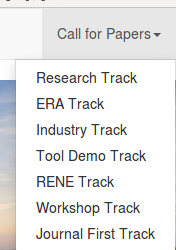文章目录
前言
这里关注一下即将在杭州召开的SANER 2019,记录如下:
1 基本信息(包括对其7个track的介绍)
主页:https://saner2019.github.io/

开会信息:
This 26th edition of the IEEE International Conference on Software Analysis, Evolution and Reengineering will be held at Zhejiang University in Hangzhou, February 24-27, 2019
文章类型有7种:

1)Research Track
这个track是展示研究长文(full length paper)的。
在这里看到一条重要信息:
We strongly encourage authors to make available all data and software they use in their work, in order to allow for verification and replication of their results.
现在可以说是非常鼓励开源自己的数据和软件了,记得之前同为IEEE旗下会议的ICSME都还没有这样的要求。
- Abstract submission deadline: October 12, 2018 AoE
2)ERA Track
全称 Early Research Achievements (ERA) track
这个track是为了展示早期工作(占坑用的?)
The goal of the ERA track is to provide researchers and practitioners with a forum for presenting promising ideas in early stages of research. These ideas do not require a strong empirical evaluation.
Important note: SANER 2019 follows a full double-blind review process. Submissions that do not adhere to these limits or that violate the formatting guidelines will be desk-rejected without review.
- Abstract submission deadline: November 28, 2018 AoE
3)Industrial Track
这个track是为了连接工业界和学术界。
This platform bridges the people from industry and academia to network, foster innovations and build strong collaborations. The papers in the industrial track follow the general topics specified in the SANER 2019 research track.
- Abstract Submission deadline: November 28, 2018 AoE
4)Tool Demo Track
感觉现在的会议安排的挺合理的,这个工具展示板块可以更好的推动软件工具的研发。
The goal of this track is to promote live presentations of tool prototypes. Software Tools are fundamental for the research in software maintenance, reverse engineering, and reengineering. These tool demonstrations have a prominent role in the SANER’19 conference, which substantially increases the visibility of the research associated to such tools.
- Abstract submission deadline: November 28, 2018
5)RENE Track
专门复现工具/实验,或者给出negative results的。
The 26th edition of the International Conference on Software Analysis, Evolution, and Reengineering (SANER’19) would like to encourage the submission of articles (1) reproducing results from previous papers and (2) reporting important and relevant negative or null results (results which fail to show an effect, yet demonstrate the research paths that did not pay off).
- Paper submission deadline: December 2, 2018 AoE
6)Workshop Track
只有两页,好短。
Workshop proposals should include the following information, with a maximum of two pages in IEEE proceedings format
- Proposal submission deadline:
September 30, 2018October 9, 2018 AoE
7)Journal First Track
中国科学信息期刊也在其中,好厉害。
The participating journals that partner with SANER are:
Empirical Software Engineering (EMSE)
IEEE Software
Journal of Systems and Software (JSS)
Information and Software Technology (IST)
Journal of Software: Evolution and Process (JSEP)
Software Quality Journal (SQJ)
Science China Information Sciences
第一次看到下面的规定:中了这个track的人必须来attend会议,不然就取消资格。
Presentation
At least one author of each accepted J1C2 contribution must register and attend the conference to present the paper. Failure to present the paper might result in exclusion from future J1C2 programs. The J1C2 papers will not be part of the SANER proceedings. Instead they will be published through the journals.
- Submission: November 9, 2018, 23:59 AoE
2 感兴趣的文章列表
Kui Liu, Anil Koyuncu, Dongsun Kim and Tegawendé F. Bissyandé. AVATAR : Fixing Semantic Bugs with Fix Patterns of Static Analysis Violations
Dongsun Kim应该是APR的元老了吧
Farima Farmahinifarahani, Vaibhav Saini, Di Yang, Hitesh Sajnani and Cristina Lopes. On Precision of Code Clone Detection Tools
代码克隆的。
Luyao Ren, Shurui Zhou, Christian Kästner and Andrzej Wąsowski. Identifying Redundancies in Fork-based Development
关于fork的,感觉以后肯定会用到。
Fernanda Madeiral, Simon Urli, Marcelo Maia and Martin Monperrus. BEARS: an Evolvable Java Bug Benchmark for Automatic Program Repair Studies
演化的benchmark???
Martin White, Michele Tufano, Matias Martinez, Martin Monperrus and Denys Poshyvanyk. Sorting and Transforming Program Repair Ingredients via Deep Learning Code Similarities
Lutz Büch and Artur Andrzejak. Learning-based Recursive Aggregation of Abstract Syntax Trees for Code Clone Detection
Zhuo Zhang, Yan Lei, Xiaoguang Mao and Panpan Li. CNN-FL: An Effective Approach for Localizing Faults Using Convolutional Neural Networks
Xiao Yu, Kwabena Ebo Bennin, Jin Liu, Jacky Wai Keung, Xiaofei Yin and Zhou Xu. An Empirical Study of Learning to Rank Techniques for Effort-Aware Defect Prediction
Chunhua Yang and E. James Whitehead. Pruning the AST with hunks to speed up tree differencing
总结
看了一下SANER 2019收录的文章列表(https://saner2019.github.io/program/accepted.html ),觉得有机会得好好研究一下,最好能够把里面的模式挖掘出来。目前的感觉是:
1)文章要被收录,你的工作一定要有意义,对软件领域没有contributions的工作是很难被评委认可的;(所以以后写文章先评估自己的idea,出发点)
2)多思考,多做实验。
刚刚又看了一遍Dongsun Kim的CV letter(https://www.darkrsw.net/cv.pdf ),本科和硕士期间GPA都是3.8以上的猛人,他也和很多牛人都有交集:David Lo , Andreas Zeller,S. C. Cheung
突然觉得博士期间很短,真正要做些有意义的工作出来很不容易。
3年看似很长,但是能发出几篇文章呢?
只能尽己所能去探索领域,尽量有所贡献。(而不是发水文,感觉自己的工作得真正的有意义,才是我想发的文章)